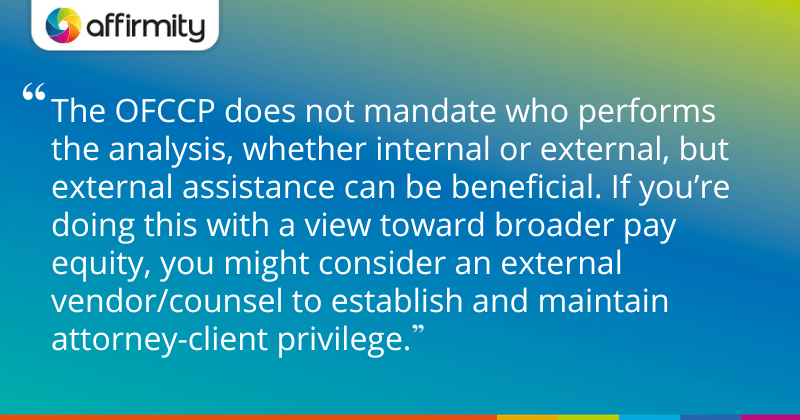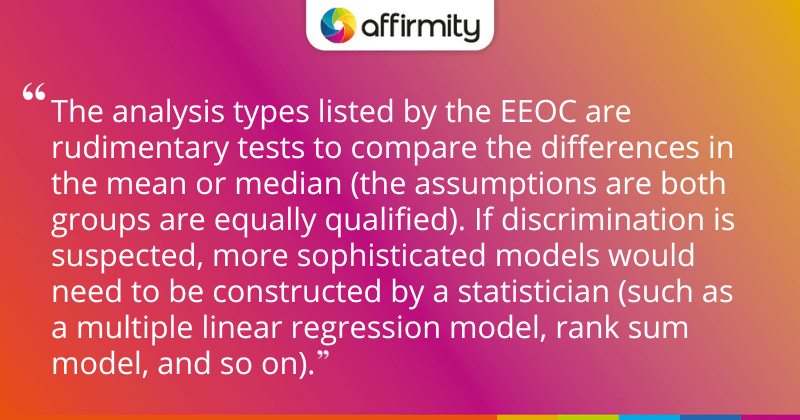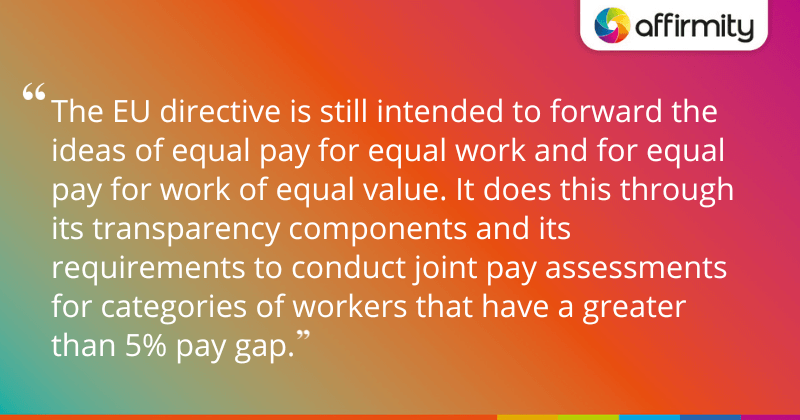Major changes to the scheduling letter in August 2023 now require federal contractors to be prepared to provide two years of compensation data in the event of an OFCCP audit, and regularly evaluate their compensation system(s). We’ve received many questions about the new pay equity status quo, as well as queries about the European Union’s new pay gap-focused directive. In the article, Charles McGhee, PhD, draws on his experience as our lead statistician and his time with the OFCCP and EEOC to provide some answers.
Questions on Item 19: The New Two-Year Requirement
Q: Will the OFCCP Look at the Difference Between the Two-Year Files for Possible Inequities in Pay Raises?
A: Theoretically, it could look at these numbers, and I would anticipate it would not be very favorable for many organizations—there could be some large discrepancies. It’s probably worth running this kind of analysis yourself in order to anticipate what the OFCCP may say about it.
LEARN MORE ABOUT THESE UPDATES | ‘New OFCCP Pay Equity Reporting Requirements: Your Analysis Options for Mitigating Risk’
Q: Will We Need to Use a Different Type of Analysis After We Combine Two Years of Multiple Regression?
A: Once you’ve combined the data, the outcome (base, total, variable) is no longer independent (repeated measures model) and the underlying assumption is violated for the multiple linear regression (ordinary least squares regression). Therefore, the appropriate model is the random coefficient model (linear mixed model) with the time variable being the random coefficient.
Q: How Do We Handle Employees That Have a Bonus or a Shift in the Second Year of Data?
A: It can be handled, just not using the usual methodology. You won’t be able to use regular regression on this—instead, you’ll need to use a random coefficients model. This model allows individuals to have a factor in one year and not in the other.
Questions on Item 22: Compensation System Evaluation

Q: Are t-Tests Sufficient for Evaluating Your Compensation System? And What Is Considered a “Small” Sample Size?
A: While a t-test is an appropriate test, the downside to using a t-test is that you’re really just comparing the two averages, and you can’t control for anything.
You’re probably fine if you’ve got at least five people—so two in one group and three in another. But if the split is one male and four females, it’s likely to be less viable. Though the test could be run with fewer, five individuals gives you a better chance of uncovering any discrepancy, should it exist.
Q: Is the OFCCP Mandating That Federal Contractors Perform a Pay Equity Study With an External Vendor or Are We Fine With Handling It Internally?
A: The OFCCP does not mandate who performs the analysis, whether internal or external, but external assistance can be beneficial. If you’re only doing this for compliance purposes, you’re likely to be fine with internal resources. If you’re doing this with a view toward broader pay equity, you might consider an external vendor/counsel to establish and maintain attorney-client privilege.
HOW PAY EQUITY SOFTWARE CAN HELP | ‘6 Pay Equity Analysis Software Features That Simplify Your Process’
General Questions on Pay Equity Analysis and Auditing

Q: Most of Our Employees Are SCA, and Wages Are Governed By the Contract. Will the OFCCP Expect an Analysis for These Employees as Well?
A: Historically, it hasn’t been necessary to analyze anybody under a collective bargaining agreement. In the last five years, we’ve seen audits start to request this information and the text of the collective bargaining agreement itself. We assume the OFCCP is analyzing it, but we’re not aware of it finding anything or bringing anything in such data to the attention of contractors. So we know it’s asking for it, but we’re not sure what it’s doing with it, or indeed, what it could do with it.
Q: How Would You Recommend Handling Two Separate Company Files for an Acquired Company During an OFCCP Audit?
A: Depending on the amount of time from the merger date, you could either analyze them separately or combine them for analysis. If you combine them, I would consider adding an extra factor (for example, “acquired company Y/N”) to the regression models.
Q: Do You Have Any Thoughts on the EEOC’s Threshold Statistical Test as a Recommended Method for Analyzing Pay?
A: This is meant to be used as threshold analysis by a less technical audience—it allows you to determine if further review is necessary. The analysis types listed by the EEOC are rudimentary tests to compare the differences in the mean or median (the assumptions are both groups are equally qualified). If discrimination is suspected, more sophisticated models would need to be constructed by a statistician (such as a multiple linear regression model, rank sum model, and so on).
Q: Are We Obligated to Record All Education Listed on a Resume?
A: In our experience, you don’t have to record everything and you don’t necessarily have to validate it. The highest credential a candidate holds is usually sufficient. This is considered self-reported and it’s ok to take that on faith for our purposes.
KEEP LEARNING ABOUT PAY EQUITY | ‘A 5-Point Plan for Designing a Culture That Embraces Pay Equity’
Questions on EU Directive 2023/970

Q: What Is the Typical Root Cause for a Pay Gap, and What Can We Take Away From This?
So the “pay gap”, as preferred by the EU in its recent directive, is different conceptually to “pay equity”, as we’re usually focused on here in the US. For all practical purposes, the pay gap is a descriptive statistic of the gender data—the rate or ratio of one gender group to the other. There’s no inferential analysis/statistic that can be ascertained from the methodology.
The EU directive is still intended to forward the ideas of equal pay for equal work and for equal pay for work of equal value. It does this through its transparency components and its requirements to conduct joint pay assessments for categories of workers that have a greater than 5% pay gap.
So if you were trying to analyze your root causes, you could look at your distribution: who is in your lowest 25%, or your top 25%, and then other smaller intervals of both lowest and highest paid. If there’s an imbalance between the groups, you could be looking at factors such as your progression program and other aspects of your employee lifecycle.
The Affirmity team can offer support on upcoming changes to your reporting obligations, answer your questions and help you better prepare for compliance. Contact us today and find out how we can help.
About the Author
 Charles McGhee, PhD serves as Affirmity’s lead statistician. He has over 20 years of expertise in workforce compliance, in the private and public sectors. Prior to joining Affirmity, he served for 10 years as senior statistician with the Office of Federal Contract Compliance Programs (OFCCP) and Equal Employment Opportunity Commission (EEOC). Dr. McGhee holds a PhD in Biostatistics, and undergraduate and Master’s degrees in Mathematics.
Charles McGhee, PhD serves as Affirmity’s lead statistician. He has over 20 years of expertise in workforce compliance, in the private and public sectors. Prior to joining Affirmity, he served for 10 years as senior statistician with the Office of Federal Contract Compliance Programs (OFCCP) and Equal Employment Opportunity Commission (EEOC). Dr. McGhee holds a PhD in Biostatistics, and undergraduate and Master’s degrees in Mathematics.
